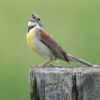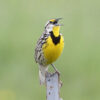
Ruby-throated Hummingbird, Archilochus colubris
Bill Rowe
Hummingbirds surely possess the most Guinness Book awards: as a group, they are the smallest birds in the world, have the fastest wingbeat and highest metabolism, build the tiniest nests…and the list goes on. The family is centered in the tropics, where they have evolved an incredible array of colors and lifestyles among 350 species, while in the United States we have about 15 regular species and here in the East just one, the Ruby-throated Hummingbird. Yet this one represents all the finest traits of the clan: their aggressiveness, their multiple mates, their…wait, perhaps that should be their beauty and energy (but we have to take nature as it really is). Hummingbirds consume a lot of nectar from flowers; that’s what they are built to do, with their long bills, extensible tongues, and unique ability to hover and back up in flight. And, luckily, they are happy to visit the flowers in our yards if we have planted suitable ones (see the Bring Conservation Home program), and also to visit our feeders for their sugar intake. They need protein too, however, and they get that by eating a wide variety of little insects and spiders.
IDENTIFICATION: There is nothing like a hummingbird (except a hawk moth). Adult males have iridescent throat feathers that shine red when the lighting is right and look simply black when it’s wrong. Females lack the glittering throat and are basically green above and whitish below, as are young males. Of the other U.S. hummingbirds that have occasionally visited Missouri, the most likely is the Rufous Hummingbird, of which the male is easily recognized, with its foxy rusty-brown color all over and a flaming orange-red throat. And any other hummingbird that does not seem to fit the standard patterns of Ruby-throated could be a rarity and should be checked out.
ST. LOUIS STATUS: The Ruby-throat is a common migrant and summer resident, with typical first arrivals in early April and typical first departures (and arrival of southbound fall migrants) in late July. Many of our hummingbirds may actually cross the Gulf of Mexico nonstop, to winter in Middle America (Mexico to Panama).
Learn more and listen to the call notes of Ruby-throated Hummingbirds here.




